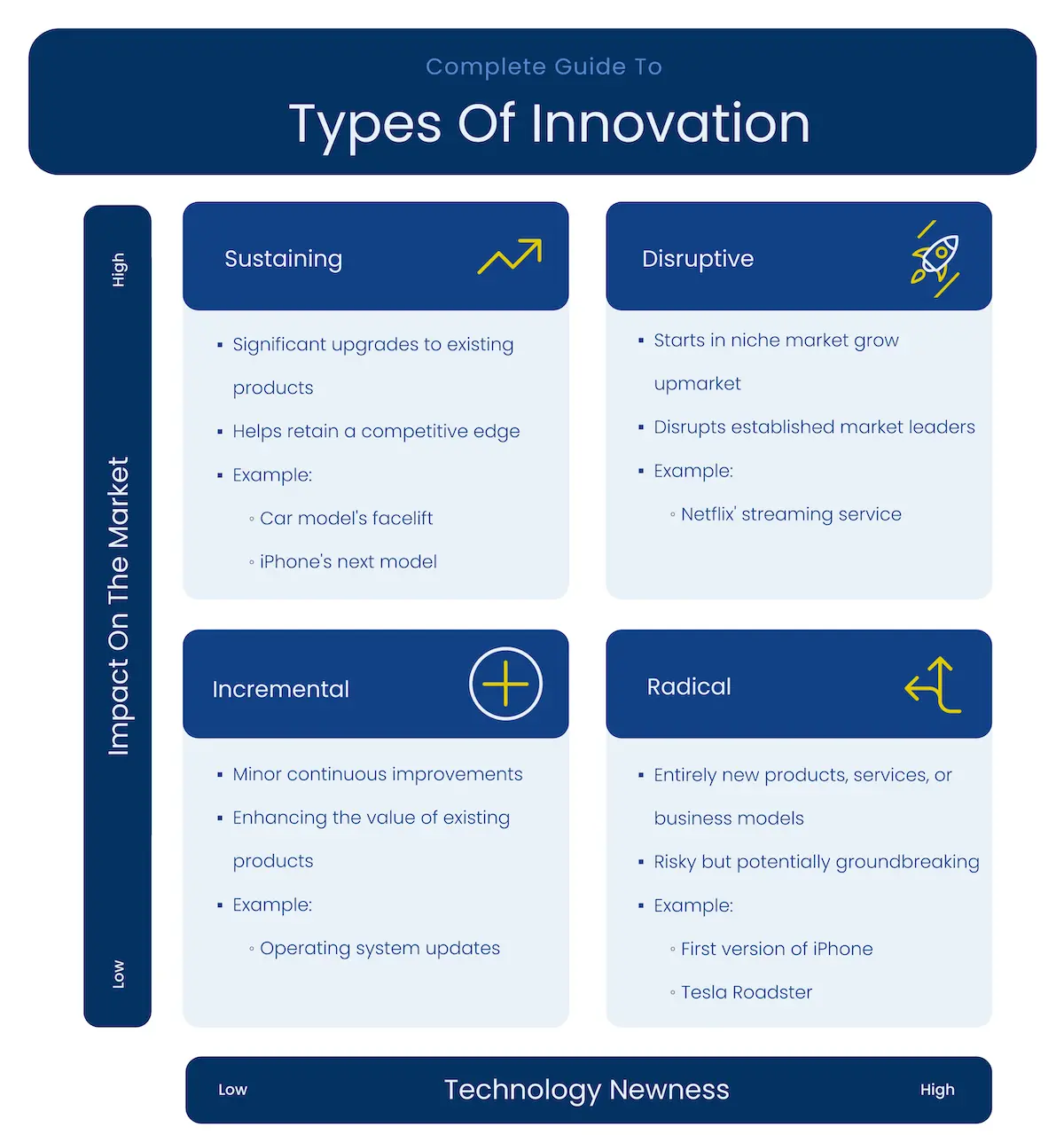4 Innovation Types for Sustainable Business Success
Aug 22, 2024 • 10 min read
Ready to turn your entrepreneurial dreams into a lasting reality? Innovation comes in many flavors. How do you pick the one that you need? Let’s see ...
What is Innovation?
Defining Innovation
At its core, innovation involves introducing something new or improving existing processes, products, or services. This could mean:
- developing groundbreaking technologies,
- finding novel ways to solve problems,
- making incremental improvements to stay competitive,
- introducing process innovation,
- business model innovation.
How Innovation Works
Innovation isn’t just about having an “Eureka!” moment. It’s a systematic process that involves research, creativity, and execution.
Entrepreneurs and product leaders often start by identifying a problem or an opportunity. From there, they brainstorm potential solutions, prototype their ideas, test them, and refine them based on feedback. Pushing the boundaries of what is considered possible can unlock innovation.
4 Types of Innovation in Business
1. Incremental Innovation
Incremental innovation, also known as continous innovation, is about making minor, continuous improvements to existing products, services, or processes. Think of it as a slow and steady race rather than a sprint. This type of innovation focuses on enhancing the value of your existing offer without drastically changing its core.
For example, consider the smartphone industry. Each new model typically features better cameras, faster processors, and improved battery life. These are incremental changes that keep customers interested and coming back for more.
2. Sustaining Innovation
Sustaining innovation takes things up a notch. It involves significant upgrades to existing products or services that help a company maintain its competitive edge.
In the automotive industry, creating hybrid engines between ICE and electric engines is a good example of sustaining innovation. It significantly improves existing car models, extending their lifespan.
3. Radical Innovation
Radical innovation is where things get exciting. This type of innovation is about creating new products, services, or business models that didn’t exist before. It pushes the boundaries and challenges the norms. Radical innovation can be risky, but it can lead to huge wins.
Electric cars were a radical innovation in their early days. They were an innovative product that needed traction to prove its market impact. Today, electric cars look more like disruptive innovations as they significantly shift the car market.
4. Disruptive Innovation
Disruptive innovation is a game-changer. It refers to innovations that create new markets and value networks, often at the expense of existing ones. Disruptive innovations typically start in niche markets and gradually move upmarket, eventually displacing established players.
In his book The Innovator's Dilemma, Clayton Christensen describes how market leaders can build an innovation strategy that allows them to remain competitive and avoid being displaced by challengers.
Netflix’s move from DVD rentals to streaming is a classic example of disruptive innovation. Netflix disrupted the traditional cable TV industry by offering a convenient and affordable way to watch content. That came at the expense of Blockbuster - a longtime market leader.
Disruptive innovation can be a powerful tool for startups looking to challenge industry giants and reshape the competitive landscape.

Why is Innovation so Important Nowadays?
Innovation isn’t just a buzzword; it’s an essential process for a product company to succeed. Here are some key benefits of innovation:
1. Competitive Advantage
Innovation helps businesses differentiate themselves from competitors. By introducing discontinuous innovation, challengers can enter the market and become among the leading players. Employing continuous innovation helps to keep that momentum and retain a competitive edge. Innovation is one key way to develop unfair advantages.
2. Enhanced Customer Experience
Innovation allows businesses to meet evolving customer needs and expectations. This could happen through:
- improved product features,
- more efficient processes,
- personalized services.
Innovation enhances the overall customer experience, and happy customers are loyal customers.
3. Market Expansion
Innovative businesses can tap into new markets and expand their reach. By developing unique solutions, companies can address unmet needs and capture new customer segments. This diversification reduces reliance on a single market and increases resilience.
4. Productivity
Innovation isn’t just about flashy new products; it’s also about improving internal processes. By adopting innovative technologies and practices, businesses can streamline operations, reduce costs, and boost productivity. Efficiency gains translate to higher profits.
5. Attracting Talent
Innovative companies are magnets for top talent. As Steve Jobs said:
an "A" player will be attracted to working with other "A" players.
Attracting and retaining the best minds in the industry is crucial for sustained success.
Innovation Strategies for Different Business Stages
Startups
Startups are typically focused on products that have big market potential. By definition, they don’t have existing products to build upon.
The most common path is radical innovation, which eventually grows into disruptive innovation.
Scaleups
Scaleups have products that achieve product-market fit and are focused on maximizing their impact. In this setup, innovation was already introduced at an earlier stage of the company, and now the focus can be shifted to leveraging that innovation.
Enterprise companies
Enterprise companies usually have a suite of products. At least one has achieved product-market fit, been scaled, and is now in the later stages of its lifecycle.
At this point, enterprise companies need to invest in new products by leveraging any of the four types of innovation to increase their chances of success and diversify their product portfolio with even more successful products.
Kickstarting Innovation in Your Company
If you are wondering how to start innovating in your company, here are some directions you can explore.
Culture of Innovation
Creating a culture of innovation is a key responsibility of the organizational leader who wants to build teams that embrace innovation. A culture of innovation fosters and celebrates innovation. It’s a complex set of behaviors, motivations, and incentives that channel organizational energy into innovative thinking.
Tools and Frameworks
There are multiple frameworks and tools that can help you design a product development process that is optimized for innovation. Examples of such frameworks are:
The Icanpreneur Platform helps teams validate their innovative ideas and evolve them until they achieve product-market fit. The platform is based on proven methodologies and provides all the needed guidance, tooling, and examples to back up your idea with real-world data.
Future Opportunities
Product innovation is often grounded in shifts in cultural, social, behavioral, and technological changes. Trends like AI and climate change will be huge factors in future innovative products. Studying the past cycles of innovation can provide insights into what’s next.
Customers First
Putting customers at the center of your innovative efforts is essential to make sure innovation brings value. There are far too many great inventions and technologies that are locked unused in the closets.
This happens until an identified need can be solved through innovation.
Apple and the iPhone: A Deep Dive into Innovation Success
Apple’s iPhone is often praised as one of the most significant products in the modern times. It changed (or actually created) the smartphone industry and redefined how people use technology to communicate and entertain.
Let’s explore how the iPhone combined different types of innovation to create a product that dominates the market and changed an industry.
1. Radical Innovation: The Birth of the iPhone
When Apple introduced the first iPhone in 2007, it was a radical innovation in the truest sense. At the time, smartphones existed, but they were:
- largely clunky,
- business-oriented devices with physical keyboards,
- with limited internet capabilities.
Apple’s iPhone introduced a sleek, intuitive touch-screen interface, which set it apart from other smartphones on the market. Most importantly, consumers loved it.
The iPhone combined several existing technologies in a novel way:
-
Touchscreen Technology:
While touchscreens had been used in other devices, Apple was the first to create a multi-touch interface. It allowed for gestures like pinching, swiping, and tapping, which made the user experience more engaging and natural. -
Mobile Computing:
The iPhone was essentially a small computer that fit in your pocket, which had a powerful processor, internet capabilities, and a versatile operating system (iOS). This transformed how people accessed information and communicated. -
App Ecosystem:
Apple’s introduction of the App Store in 2008 was another radical innovation. By allowing third-party developers to create apps, Apple created a whole ecosystem, rapidly expanding and improving the functionality of the iPhone.
These radical innovations didn’t just create a new product. They set the stage for a new market altogether. The iPhone (re)defined what consumers expected from a mobile device. They also forced competitors to rethink their approaches, leading to the subsequent smartphone wars.
2. Sustaining Innovation: Continuous Improvement
While the first iPhone was a radical innovation, Apple’s strategy for its next models relied heavily on sustaining innovation. Each new iPhone model introduced significant improvements, often evolutionary rather than revolutionary.
-
Performance Enhancements:
Every new iPhone model featured a faster processor, better graphics, and more RAM. This improved the overall performance of the iPhone and user experience. -
Camera Improvements:
Apple also kept upgrading the iPhone’s camera, which was one of the key features people were looking at. They continued making incremental improvements to number of megapixels, low-light photos, and software-driven updates. These enhancements have made the iPhone the go-to device for mobile photography, displacing cameras. -
Battery Life:
With each iteration, Apple worked on extending the iPhone's battery life. This was an important step as it addressed one of the primary user concerns.
Sustaining innovation allowed Apple to maintain its competitive edge and keep customers in line for the latest model.
3. Incremental Innovation: Refining the User Experience
Small and continuous improvements might not make headlines, but they have played a critical role in refining the product and enhancing the user experience.
-
iOS Updates:
Apple regularly releases updates to its iOS operating system, adding new features (widgets, Face ID improvements, UI changes), fixing bugs, and improving security. -
Material Choices:
Over the years, Apple has made subtle changes to the materials used in the iPhone’s construction. Switching from plastic to aluminum and then to glass improved the device’s durability, look and feel, and wireless charging capabilities.
Thanks to such incremental improvements, the iPhone buyer keeps getting move value even without buying the latest model.
4. Disruptive Impact on the Market
While Apple’s iPhone began as a radical innovation, its impact on the market was disruptive. The iPhone didn’t just compete with existing smartphones - it redefined what a smartphone was. This, in turn, led to the decline of companies that couldn’t keep up with this new standard.
-
Nokia and BlackBerry:
Before the iPhone, Nokia and BlackBerry were dominant players in the mobile phone market. However, they were slow to adapt to the touch-screen, app-centric model that the iPhone introduced. As a result, they lost significant market share, with BlackBerry eventually exiting the consumer market altogether. -
The App Economy:
The introduction of the App Store was a disruptive force on its own. The ability to create and distribute apps directly to consumers’ smartphones transformed whole industries:- gaming
- media
- banking
This ecosystem has also fostered innovation in software development, creating billion-dollar companies like Instagram, WhatsApp, and Uber.
Wrap Up
Innovation is not a luxury. It’s a necessity for sustainable business success. By leveraging these four types of innovation, entrepreneurs and product leaders can drive growth, stay competitive, and create lasting value.
Ready to take your innovation game to the next level? Start your Icanpreneur trial to unleash the innovation in your organization.
Author
Product @ Icanpreneur. Coursera instructor, Guest Lecturer @ Product School and Telerik Academy. Angel Investor. Product manager with deep experience in building innovative products from zero to millions of users.
